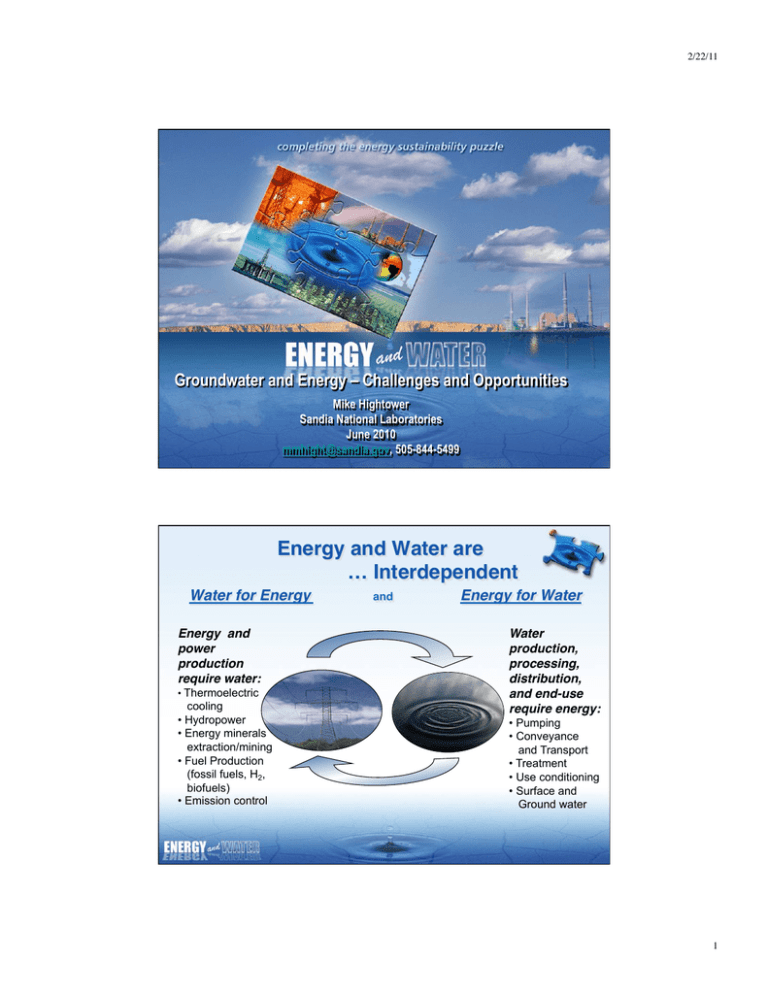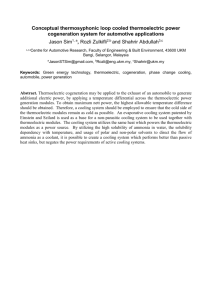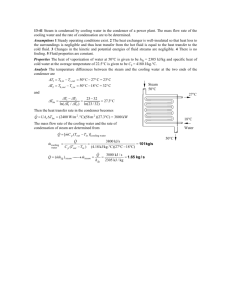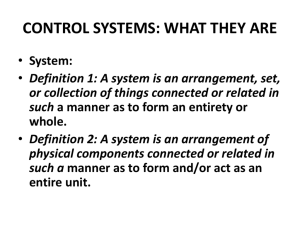Document 14248662
advertisement

2/22/11 Groundwater and Energy – Challenges and Opportunities Mike Hightower Sandia National Laboratories June 2010 mmhight@sandia.gov, 505-844-5499 Energy and Water are … Interdependent Water for Energy Energy and power production require water:! • Thermoelectric cooling • Hydropower • Energy minerals extraction/mining • Fuel Production (fossil fuels, H2, biofuels) • Emission control " and Energy for Water! Water production, processing, distribution, and end-use require energy: • Pumping • Conveyance and Transport • Treatment • Use conditioning • Surface and Ground water 1 2/22/11 Growing Limitations on Fresh Surface and Ground Water Availability" • Little increase in surface water storage capacity since 1980 • Concerns over climate impacts on surface water supplies ( Based on USGS WSP-2250 1984 and Alley 2007) • Many major ground water aquifers seeing reductions in water quality and yield (Shannon 2007) Regional Growth in Thermoelectric Power Generation" Projected Thermoelectric Increases (Capacity in 2025 vs 1995) • Most growth in regions that are already water stressed • Most new plants expected to use evaporative cooling because of EPA 316 A &B requirements Source: NETL, 2004 2 2/22/11 Water Use and Consumption for Electric Power Generation" Plant-type Fossil/ biomass steam turbine Nuclear steam turbine Natural Gas Combined-Cycle Integrated Gasification Combined-Cycle Water Use Intensity (gal/MWhe) Cooling Process Steam Condensing Other Uses Withdrawal Consumption Open-loop 20,000–50,000 ~200-300 Closed-loop 300–600 300–480 Open-loop 25,000–60,000 ~400 Closed-loop 500–1,100 400–720 Open-loop 7,500–20,000 100 Closed-loop 230 180 Closed-loop 200 180 Carbon sequestration for fossil energy generation Consumption ~30 ~30 7–10 150 ~60% increase in water withdrawal and consumption Geothermal Steam Closed-loop 2000 1350 50 Concentrating Solar Closed-loop 750 740 10 Wind and Solar Photovoltaic N/A 0 0 1-2 Water Demands for Future Electric Power Development " • Carbon emission requirements will increase water consumption by an additional 1-2 Bgal/day 9 8 Water Consumption ( billion gallons per day) • Water demands could almost triple from 1995 consumption for projected mix of plants and cooling 7 6 5 4 3 2 1 0 1995 2005 2015 2025 2035 Year 3 2/22/11 Biomass and Water Use Impacts Will be Regional" Oil Shale development will be regional and impact water availability and quality " • Reserves are in areas of limited water resources • Water needed for retorting, steam flushing, and cooling up to 3 gallons per gallon of fuel • Concerns over in situ migration of retort byproducts and impact on ground water quality 4 2/22/11 Water Demand/Impact of Transportation Fuels" Emerging Water Demands for Alternative Fuels Development " 3 Water Consumption (billion gallons per day) • Irrigation of even small percentage of biofuel acreage could increase water consumption by an additional 3-5 Bgal/day 2.5 Alt Fuels 2 Biofuels 1.5 Traditional Refining 1 0.5 0 1995 2005 2015 2025 2035 Year 5 2/22/11 Water Consumption by Sector – Emerging Competing Energy Sector Demands" U.S. Freshwater Consumption, 100 Bgal/day Domestic 7.1% Livestock 3.3% Irrigation 80.6% Mining 1.2% Industrial 3.3% Commercial 1.2% Thermoelectric 3.3% [USGS, 1998] Energy uses 27 percent of all non-agricultural fresh water Growing Use of Non-traditional Water Resources " Power Requirements For Treating 10 Today 9 The Future Kwh/m^3 8 7 6 5 4 3 2 1 0 Conventional Treatment 1 (Modified from Water Reuse 2007, EPA 2004, Mickley 2003) 2 Brackish NF 3 Brackish RO 4 Sea Water RO 5 (Einfeld 2007) • Desal growing at 10% per year, waste water reuse at 15% per year • Reuse not accounted for in USGS assessments • Non-traditional water use is energy intensive 6 2/22/11 Energy Requirements of Various Water Resource Options" Water Supply Op-ons Fresh Water Importa-on (100-­‐300 miles) Seawater Desalina-on w/Reverse Osmosis Energy Demand (kWhr/kgal) 10-­‐18 12-­‐20 Brackish Groundwater Desalina-on Reverse Osmosis Treatment Pumping and concentrate management Total 7-­‐9 1-­‐3 8-­‐12 Aquifer Storage and Recovery Pre-­‐treatment (as needed) Post-­‐treatment (as needed) Pumping Total 3-­‐4 3-­‐4 2-­‐3 5-­‐11 Agricultural Biofuels Land Demands" Algae has potential advantages over corn, cellulosic materials, and other crops as an alternative to petroleum-based fuels" Gallons of Oil per Acre per Year Corn 18 Soybeans 48 Safflower 83 Sunflower 102 Rapeseed 127 Oil Palm Micro Algae 635 1000 - 7000 Wastewater use for algae is being investigated Land Needed for Biofuel to Replace 50% of Current Petroleum/Diesel using oil from: Corn Soybean Algae 7 2/22/11 Growing use of non-traditional water for thermoelectric power plant cooling " Palo Verde – largest Nuclear Power Plant in the US, uses waste water for cooling Water Pumping and Treatment for Novel Energy Storage" • Water pumping and treatment considered to support renewable energy use • Detailed matching of wind energy, water demand, and water storage by hour • Several applications have shown overall savings on water treatment and delivery costs 8 2/22/11 Summary of Major Needs Identified in " Regional Energy Water Workshops" Better resources planning and management • • • Improved water supply and demand characterization, monitoring, and modeling Integrated regional energy and water resource planning and decision support tools Framework for incorporating infrastructure, regulatory, and policy considerations for improved energy/water efficiency planning Improved water and energy use efficiency • • • Improved water efficiency in thermoelectric power generation Improved biofuels/biomass water use efficiency Reduced water intensity for emerging energy resources Development of alternative water resources and supplies • • Non-traditional and oil and gas produced water use and reuse Improved energy efficiency for non-traditional water treatment and use 9


